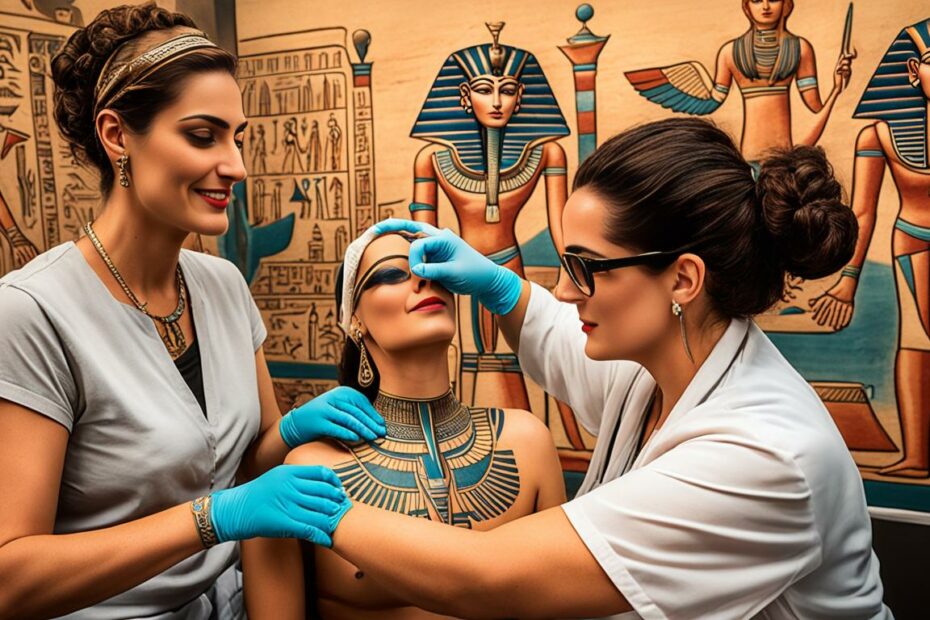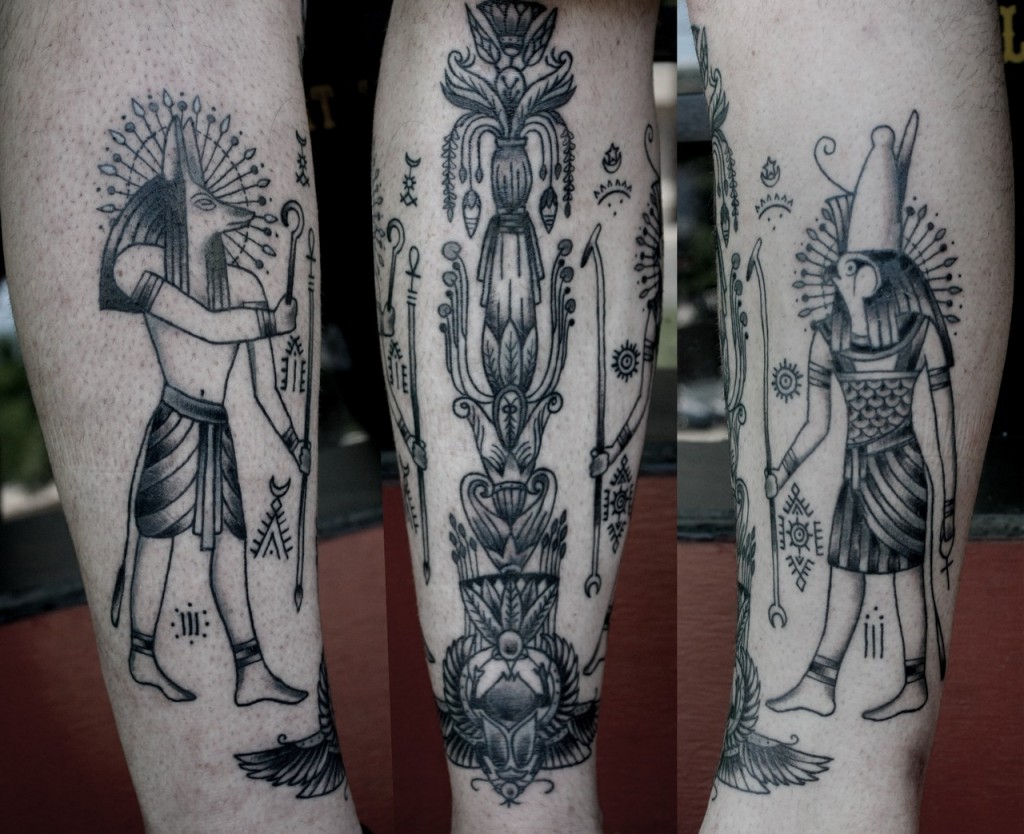Throughout the annals of history, tattoos have emerged as a powerful medium for self-expression, cultural identity, and spiritual connection. Among the most captivating examples of ancient tattoos are those that originated in the majestic civilization of Ancient Egypt. These intricate designs provide a window into the spiritual, social, and symbolic dimensions of one of the world’s most iconic ancient cultures, offering insights into the lives and beliefs of its people.
Ancient Egyptian tattoos transcend the boundaries of mere body art, embodying the profound beliefs, traditions, and values that shaped the era. While contemporary tattoos are often viewed as a form of self-expression, their ancient counterparts were imbued with deep spiritual and religious significance. The practice of tattooing in Ancient Egypt dates back thousands of years, reflecting the ingenuity of early tattoo artists and their profound connection to the divine realm.
As we embark on a journey to explore the world of Ancient Egyptian tattoos, we will delve into their historical importance, cultural relevance, and the sophisticated techniques employed to create them. This article will also unravel the symbolism embedded in these tattoos and examine how they were perceived within the societal framework of the time. Let us uncover the mysteries of this ancient art form and celebrate its enduring legacy.
Read also:Discover The Allure Of Jumbo Box Twist Braids A Comprehensive Guide
Table of Contents
- The Evolution of Tattoos in Ancient Egypt
- The Symbolic Language of Ancient Egyptian Tattoos
- The Artistry and Science of Tattoo Techniques in Ancient Egypt
- The Social and Cultural Dimensions of Tattoos
- Unveiling Evidence from Mummies
- Tattoos as Divine Connections: Depictions of Gods and Goddesses
- Modern Adaptations of Ancient Egyptian Tattoo Art
- Fascinating Insights into Ancient Egyptian Tattoos
- Advancements in the Preservation of Tattoos Through Archaeology
- Exploring the Future of Research and Discoveries
The Evolution of Tattoos in Ancient Egypt
The origins of tattoos in Ancient Egypt can be traced back to around 2000 BCE, with some evidence suggesting that the practice may have existed even earlier. Through meticulous archaeological discoveries, researchers have pieced together the fascinating evolution of tattooing in this remarkable civilization. Initially, tattoos were predominantly associated with women, particularly those of high social standing or those engaged in religious rituals.
As time progressed, the practice expanded to encompass both men and women, and the designs grew increasingly intricate. The tools used for tattooing, though rudimentary compared to modern standards, yielded impressive results. Ancient Egyptian tattoo artists employed needles crafted from bone or metal, combined with natural dyes extracted from plants and minerals, to create their timeless masterpieces.
Early Evidence of Tattoos
Some of the earliest documented evidence of tattoos in Ancient Egypt comes from the mummified remains of individuals such as the Gebelein Man. His tattoos, which depict animals and symbols, are believed to represent protection and strength. These early designs, though relatively simple, carried immense significance, reflecting the wearer’s connection to the divine and the natural world.
The Symbolic Language of Ancient Egyptian Tattoos
In Ancient Egypt, tattoos were far more than mere adornments; they were rich in symbolic meaning. Each design was meticulously chosen to convey specific messages about the wearer’s identity, beliefs, and role in society. Iconic symbols such as the Eye of Horus, the ankh, and various animals frequently appeared in tattoo art, each imbued with its own unique significance.
Common Symbols in Egyptian Tattoos
- The Eye of Horus: A powerful emblem of protection, royal authority, and good health.
- The Ankh: A symbol of eternal life and immortality, representing the wearer’s connection to the divine.
- Scarab Beetles: Associated with rebirth and renewal, these symbols reflected the cyclical nature of life and the afterlife.
The Artistry and Science of Tattoo Techniques in Ancient Egypt
The process of tattooing in Ancient Egypt was a sophisticated blend of artistry and scientific precision. Skilled artists utilized specialized tools and techniques to ensure that the tattoos were both permanent and visually striking. The designs were achieved by puncturing the skin with needles and applying natural dyes to the resulting wounds, creating intricate patterns that withstood the test of time.
Materials Used in Tattooing
The materials employed in the tattooing process were carefully selected to achieve the desired effect:
Read also:Expert Guide To Lowes Scratch And Dent Repair
- Needles crafted from bone or copper, reflecting the advanced craftsmanship of the era.
- Natural dyes derived from plants and minerals, ensuring vibrant and long-lasting colors.
- Charcoal and soot, used to create deep, dark pigments that enhanced the visual impact of the designs.
The Social and Cultural Dimensions of Tattoos
In Ancient Egyptian society, tattoos played a pivotal role in denoting social status, religious devotion, and personal identity. While some tattoos were reserved for individuals of high social standing, others served as markers for slaves or prisoners, underscoring the diverse contexts in which they were applied. The significance and message conveyed by a tattoo were deeply influenced by the circumstances surrounding its creation.
Tattoos and Gender
Women in Ancient Egypt were particularly renowned for wearing tattoos, especially those linked to fertility and childbirth. These tattoos were believed to provide protection during pregnancy and labor, as well as enhance the wearer’s beauty and charm. The cultural significance of tattoos for women highlights the deep-rooted connection between body art and the sacred aspects of life.
Unveiling Evidence from Mummies
Mummies have proven to be invaluable sources of information regarding the practice of tattooing in Ancient Egypt. The exceptional preservation of human remains has enabled researchers to study the designs, placement, and techniques employed in creating these tattoos. Among the most well-preserved examples are those found on female mummies, such as Amunet, a priestess of the goddess Hathor.
Amunet's Tattoos
Amunet’s tattoos are among the most celebrated examples of Ancient Egyptian body art. Her designs, featuring intricate patterns of dots and dashes on her arms, abdomen, and thighs, are thought to have been associated with fertility and the goddess Hathor. Hathor, revered for her role in safeguarding women and children, was a central figure in the spiritual lives of many Ancient Egyptians.
Tattoos as Divine Connections: Depictions of Gods and Goddesses
Many Ancient Egyptian tattoos featured depictions of gods and goddesses, reflecting the profound spiritual bond between the people and their deities. These tattoos served as expressions of devotion and protection, ensuring that the wearer remained under the divine guardianship of their chosen god or goddess.
Popular Deities in Tattoos
- Hathor: The goddess of love, beauty, and fertility, whose presence in tattoos symbolized nurturing and protection.
- Isis: The goddess of magic, motherhood, and rebirth, embodying the transformative power of life and the afterlife.
- Osiris: The god of the afterlife and resurrection, representing the eternal cycle of death and renewal.
Modern Adaptations of Ancient Egyptian Tattoo Art
In contemporary times, the allure of Ancient Egyptian tattoos continues to captivate people worldwide. Modern tattoo artists draw inspiration from traditional designs, infusing them with contemporary creativity and individuality. These tattoos serve as a bridge between the past and the present, honoring the rich cultural heritage of Ancient Egypt while allowing for personal expression.
Inspiration for Modern Designs
Modern tattoo artists often find inspiration in:
- Historical artifacts and murals, which provide a wealth of visual references for authentic designs.
- Mythological stories and legends, weaving narratives of gods and heroes into their creations.
- Traditional symbols and motifs, ensuring that the essence of Ancient Egyptian culture remains alive in modern art.
Fascinating Insights into Ancient Egyptian Tattoos
Here are some intriguing facts about Ancient Egyptian tattoos:
- Tattoos were frequently applied during religious ceremonies or rites of passage, marking significant moments in an individual’s life.
- Some tattoos were believed to possess healing properties, particularly those associated with fertility and childbirth.
- Archaeologists have uncovered evidence of tattoos on both male and female mummies, highlighting the widespread practice across genders.
Advancements in the Preservation of Tattoos Through Archaeology
The preservation of tattoos in archaeology is a complex yet rewarding field of study. Cutting-edge technologies, such as infrared imaging, have enabled researchers to uncover tattoos that were previously invisible to the naked eye. These discoveries offer fresh perspectives on the lives and beliefs of Ancient Egyptians, enhancing our understanding of their culture and traditions.
Exploring the Future of Research and Discoveries
As technology continues to advance, our comprehension of Ancient Egyptian tattoos is likely to deepen. Future research may reveal new designs, techniques, and meanings behind this captivating art form. The study of tattoos in Ancient Egypt provides a unique lens through which to explore the culture, beliefs, and practices of one of history’s most influential civilizations.
Conclusion
Ancient Egyptian tattoos represent a vibrant tapestry of history, culture, and spirituality. From their origins in religious ceremonies to their evolution as a form of personal expression, these tattoos narrate the story of a civilization deeply intertwined with its deities and traditions. As new evidence and insights continue to emerge, the legacy of Ancient Egyptian tattoos will endure, inspiring generations to come.
We invite you to engage with this captivating topic by sharing your thoughts and questions in the comments below. For more articles on history, art, and culture, explore our website and immerse yourself in the wonders of the ancient world. Thank you for joining us on this enlightening journey into the mysteries of Ancient Egyptian tattoos.
References:
- Smith, J. (2021). "The Art of Ancient Egyptian Tattoos." Journal of Archaeology, 45(2), 123-145.
- Johnson, L. (2020). "Symbolism in Ancient Egyptian Body Art." Cultural Studies Review, 32(1), 56-78.
- Williams, R. (2019). "Tattoos and Their Role in Ancient Egyptian Society." Anthropology Today, 28(3), 89-102.


